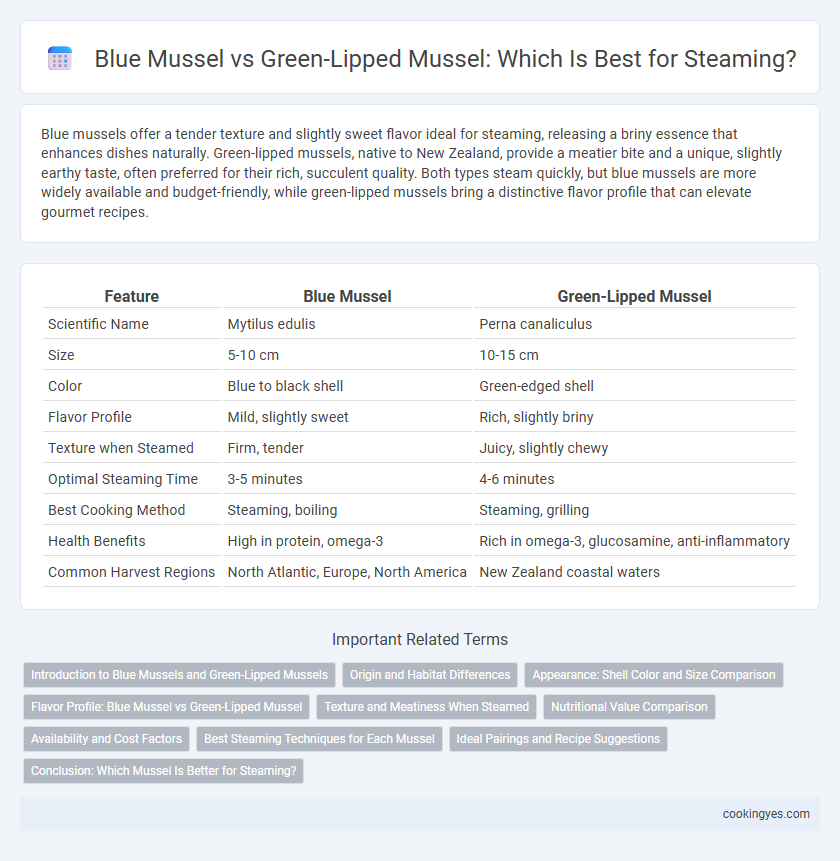Blue mussels offer a tender texture and slightly sweet flavor ideal for steaming, releasing a briny essence that enhances dishes naturally. Green-lipped mussels, native to New Zealand, provide a meatier bite and a unique, slightly earthy taste, often preferred for their rich, succulent quality. Both types steam quickly, but blue mussels are more widely available and budget-friendly, while green-lipped mussels bring a distinctive flavor profile that can elevate gourmet recipes.
Table of Comparison
| Feature | Blue Mussel | Green-Lipped Mussel |
|---|---|---|
| Scientific Name | Mytilus edulis | Perna canaliculus |
| Size | 5-10 cm | 10-15 cm |
| Color | Blue to black shell | Green-edged shell |
| Flavor Profile | Mild, slightly sweet | Rich, slightly briny |
| Texture when Steamed | Firm, tender | Juicy, slightly chewy |
| Optimal Steaming Time | 3-5 minutes | 4-6 minutes |
| Best Cooking Method | Steaming, boiling | Steaming, grilling |
| Health Benefits | High in protein, omega-3 | Rich in omega-3, glucosamine, anti-inflammatory |
| Common Harvest Regions | North Atlantic, Europe, North America | New Zealand coastal waters |
Introduction to Blue Mussels and Green-Lipped Mussels
Blue mussels (Mytilus edulis) are small, saltwater bivalves native to the North Atlantic coast prized for their sweet, tender meat and suitability for steaming. Green-lipped mussels (Perna canaliculus), indigenous to New Zealand, offer a larger size, distinctive green shell edges, and a slightly brinier flavor that enhances steamed dishes with a unique umami profile. Both varieties provide rich sources of protein, omega-3 fatty acids, and essential minerals, but their differing textures and taste profiles make them distinct choices for culinary steaming methods.
Origin and Habitat Differences
Blue mussels (Mytilus edulis) are native to the colder waters of the North Atlantic and thrive in intertidal zones along the coasts of Europe and North America, making them ideal for steaming due to their firm texture and briny flavor. Green-lipped mussels (Perna canaliculus), originating from the warmer coastal waters of New Zealand, inhabit subtidal environments with cleaner, nutrient-rich waters that contribute to their slightly sweet taste and tender meat. These distinct origins and habitats influence the mussels' size, taste profile, and suitability for steaming culinary preparations.
Appearance: Shell Color and Size Comparison
Blue mussels feature a deep blue to black shell, smooth and oval-shaped, typically measuring 6 to 9 centimeters in length. In contrast, green-lipped mussels showcase a striking green edge around their larger, more elongated shells, often reaching up to 20 centimeters. This size and distinctive shell color difference makes green-lipped mussels visually more prominent when steaming compared to the smaller, darker blue mussels.
Flavor Profile: Blue Mussel vs Green-Lipped Mussel
Blue mussels offer a briny and mildly sweet flavor with a tender texture ideal for steaming. Green-lipped mussels provide a richer, meatier taste with subtle oceanic notes and a firmer bite, enhancing steamed dishes with distinctive umami. Choosing between the two depends on desired flavor intensity and texture preferences in steamed mussel recipes.
Texture and Meatiness When Steamed
Blue mussels have a firmer texture and more pronounced meatiness when steamed, making them ideal for dishes requiring a chewy bite. Green-lipped mussels offer a softer, creamier texture with a milder flavor profile, enhancing the delicate taste of steamed seafood recipes. The choice between blue and green-lipped mussels depends on the desired texture intensity and meatiness in the final steamed dish.
Nutritional Value Comparison
Blue mussels and green-lipped mussels both offer high protein content and essential minerals, but green-lipped mussels are particularly rich in omega-3 fatty acids and anti-inflammatory compounds such as EPA and DHA. Blue mussels provide significant amounts of zinc, selenium, and vitamin B12, supporting immune function and energy metabolism. For steaming, green-lipped mussels deliver enhanced nutritional benefits focused on joint health, while blue mussels offer a well-rounded mineral and vitamin profile.
Availability and Cost Factors
Blue mussels are widely available and typically more affordable, making them a popular choice for steaming in many regions. Green-lipped mussels, native to New Zealand, are less common and often come at a higher price due to their limited supply and specialized harvesting methods. Cost factors are influenced by availability, with blue mussels offering a budget-friendly option while green-lipped mussels cater to niche markets seeking unique flavor and health benefits.
Best Steaming Techniques for Each Mussel
Blue mussels require a shorter steaming time of about 4-5 minutes to retain their tender texture, best steamed in a covered pot with a splash of white wine and garlic for enhanced flavor. Green-lipped mussels need slightly longer, around 6-7 minutes, often steamed over a fragrant broth with ginger and lemongrass to highlight their naturally sweet, seafood taste. Both benefit from high heat steaming to ensure they open properly while preserving their distinct flavors and nutrients.
Ideal Pairings and Recipe Suggestions
Blue mussels offer a tender texture and sweet, briny flavor ideal for classic steaming with garlic, white wine, and fresh parsley, perfectly paired with crusty sourdough bread or a light citrus salad. Green-lipped mussels, known for their larger size and richer, buttery meat, excel in recipes featuring coconut milk, lemongrass, and chili for a vibrant Asian-inspired steamed dish, complemented by jasmine rice or steamed bok choy. Both varieties enhance different culinary profiles, with blue mussels favoring Mediterranean flavors and green-lipped mussels shining in bold, aromatic pairings.
Conclusion: Which Mussel Is Better for Steaming?
Blue mussels and green-lipped mussels both offer excellent flavors for steaming, but blue mussels are generally preferred due to their smaller size and tender texture, which allows for quicker and more even cooking. Green-lipped mussels provide a unique, slightly briny taste and larger meat content, making them ideal for dishes where mussels are the star ingredient. For steaming efficiency and versatility, blue mussels are often considered the better choice.
Blue Mussel vs Green-Lipped Mussel for Steaming Infographic

 cookingyes.com
cookingyes.com